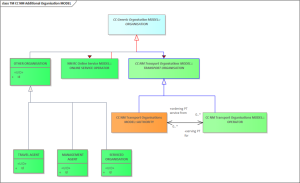Difference between revisions of "FAQ Transmodel"
| Line 64: | Line 64: | ||
The functional similarity of the VEHICLE MEETING LINK with a SERVICE LINK for a CONVENTIONAL MODE OF OPERATION means: '''it is a link along which no pick-up/drop-off operation can take place.''' | The functional similarity of the VEHICLE MEETING LINK with a SERVICE LINK for a CONVENTIONAL MODE OF OPERATION means: '''it is a link along which no pick-up/drop-off operation can take place.''' | ||
| + | |||
| + | === VEHICLE MEETING POINT IN PATH === | ||
| + | |||
| + | ==== Is it modeled right? ==== | ||
| + | POINT IN SERVICE PATTERN can also be each intermediate point, which is not a VEHICLE MEETING POINT. It is not 2 but an infinite amount of those in the SINGLE JOURNEY according to the diagram. | ||
| + | [[File:SERVICE PATTERN 1.png|thumb]] | ||
Revision as of 19:20, 7 February 2023
Conceptual modelling – separating concerns & identifying analogies
ORGANISATION DAY TYPE
What is it really used for and why is it modeled so complex?
Transmodel provides the concept of DAY TYPE defined as a type of day characterised by one or more properties which affect public transport operation. For example: weekday in school holidays.
This concept is intended to be used by organisations (in particular operators) in charge of the planning of public transport services.
Transmodel provides the following types of organisations:
A TRANSPORT ORGNISATION is providing transport services related to particular modes of operation.
Other types of organisations exist, in particular SERVICED ORGANISATIONs which are public or private organisations for which public transport services are provided on specific days, e.g. a school, university or works.
ORGANISATION DAY TYPE is a DAY TYPE that is defined in terms of operation or not operation of a referenced SERVICED ORGANISATION (specific DAY TYPE).
This concept is used to describe a reality proper to an organisation serviced by public transport.
Example:
PT services are defined for DAY TYPES Monday, Tuesday, Wedenesday, Thursday, Friday. Some schools in France are closed on Wedensdays, so the service is not required on Wednesdays.
In this case we have ORGANISATION DAY TYPEs:
· Monday-Tuesday-Thursday-Friday characterised by 'isServiceDay' = true and
· Wednesday charactrised by ' isServiceDay '= false.
The additional attribute 'isServiceDay' is present in NeTEx.
INDIVIDUAL PASSENGER INFO
Why is INDIVIDUAL PASSENGER INFO not just a structure within INDIVIDUAL TRAVELLER?
An INDIVIDUAL TRAVELLER may be a driver (e.g. in car pooling) or a passenger .
Therefore we have both: INDIVIDUAL PASSENGER INFO and VEHICLE POOLING DRIVER INFO.
Here, the roles of an INDIVIDUAL TRAVELLER are separated and the attributes reflect the main requirements/characteristics related to each role.
NB: the list of attributes reflects the MAIN characteristics allowing to describe the semantics of a concept – NeTEx provides in may cases some more properties.
VEHICLE MEETING LINK
Some conceptual explanation would be nice (and better description).
Transmodel provides data structures for conventional modes of operation. Some basic concepts are VEHICLE JOURNEY, SERVICE PATTERN, SCHEDULED STOP POINT, SERVICE LINK, etc
As regards alternative mode of operation, similar concepts do exist:
· The SINGLE JOURNEY hast to be seen at the same functional level as a VEHICLE JOURNEY, but without the associated DAY TYPE/CALENDAR (only associated to a OPERTING DAY).
· The SINGLE JOURNEY PATH is at the same level as the SERVICE PATTERN: the SERVICE PATTERN is a sequence of SCHEDULED STOP POINT, and the SINGLE JOURNEY PATH is a sequence of VEHICLE MEETING POINTS.
· Both SINGLE JOURNEY PATH and SERVICE PATTERN are related to a schematic itinerary: a ROUTE.
· The SERVICE LINK (link between tso SCHEDLED STOP POINTS) has to be seen at the same functional level as a VEHICLE MEETING LINK (link between two VEHICLE MEETING POINTs).
The functional similarity of the VEHICLE MEETING LINK with a SERVICE LINK for a CONVENTIONAL MODE OF OPERATION means: it is a link along which no pick-up/drop-off operation can take place.
VEHICLE MEETING POINT IN PATH
Is it modeled right?
POINT IN SERVICE PATTERN can also be each intermediate point, which is not a VEHICLE MEETING POINT. It is not 2 but an infinite amount of those in the SINGLE JOURNEY according to the diagram.

